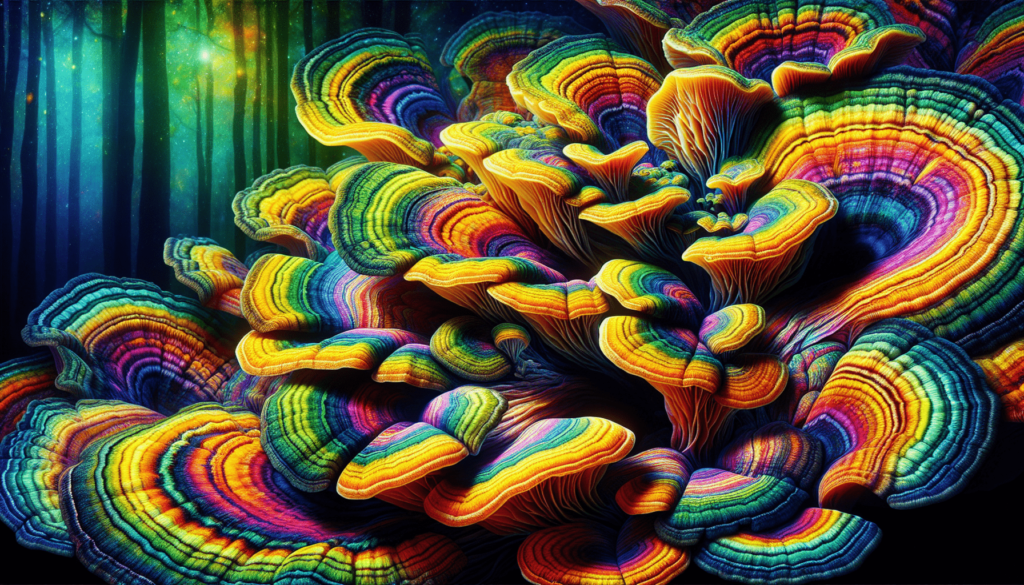Step into the mesmerizing world of Trametes Versicolor, where vibrant hues intertwine to create a kaleidoscope of colors. This enigmatic fungi, commonly known as turkey tail, showcases a captivating display of multicolored patterns that capture the imagination. From the forest floor to the decaying logs, Trametes Versicolor reveals its presence through its distinctive and diverse appearance. With its rich palette of blues, greens, reds, and browns, this captivating organism is a testament to the beauty and intricacy of nature. Explore the enchanting world of Trametes Versicolor and marvel at the wonders that await.
Overview of Trametes Versicolor
Trametes Versicolor, commonly known as the Turkey Tail mushroom due to its colorful and patterned appearance, is a fascinating organism that holds immense value in various fields. With its distinct physical attributes, widespread distribution, and significant medicinal uses, Trametes Versicolor has captured the attention of scientists, artists, and conservationists alike. In this comprehensive article, we will delve into the multifaceted nature of Trametes Versicolor, exploring its physical appearance, habitat, cultural significance, ecological role, biological characteristics, chemical composition, medical applications, ongoing research, cultivation and harvesting techniques, environmental threats, and conservation efforts for this incredible mushroom.
Physical Appearance
Trametes Versicolor is a bracket fungus that boasts a vibrant and intricate display of colors. Its cap resembles the tail of a turkey, presenting a spectrum of hues ranging from deep blues and greens to vibrant oranges and browns. These beautifully banded concentric zones give the mushroom its common name, Turkey Tail. The cap’s surface is velvety and smooth, while the underside reveals a porous pattern of tiny pores, where the mushroom releases its spores for reproduction. With a diameter of around 5-10 centimeters, the cap of Trametes Versicolor is a striking sight amidst the lush greenery of forests.
Habitat and Distribution
Trametes Versicolor is a globally distributed mushroom that can be found in various habitats across the world. It favors temperate forests, thriving on decaying wood from both hardwood and coniferous trees. This versatile mushroom can be spotted in North America, Europe, Asia, and other regions with suitable climates. Whether nestled on fallen logs or adorning tree trunks, Trametes Versicolor is nature’s artistic masterpiece, bringing a burst of color to its surroundings.
Medicinal Uses
Throughout history, Trametes Versicolor has been revered for its medicinal properties and has been used in traditional medicine practices. Many cultures have recognized its potential to boost the immune system and promote overall well-being. Studies have shown that Trametes Versicolor contains bioactive compounds, including polysaccharides and beta-glucans, which possess immunomodulatory properties. These compounds have the ability to regulate and enhance the immune response, making Trametes Versicolor a promising natural remedy for various ailments.
Cultural Significance of Trametes Versicolor
Symbolism in Art and Literature
The captivating beauty of Trametes Versicolor has inspired artists and writers throughout the ages. Its vibrant colors and unique patterns have become symbols of the natural world’s artistic splendor. In many cultures, this mushroom is associated with harmony, balance, and renewal. The intricate bands and concentric circles of the mushroom’s cap have been incorporated into various forms of art, serving as a visual representation of the interconnectedness of all living things.
Traditional Folklore and Beliefs
Trametes Versicolor holds a special place in traditional folklore and beliefs around the world. In some cultures, it is believed that this mushroom possesses magical properties, bringing good fortune and protection. Folk healers have utilized Trametes Versicolor to treat ailments and promote longevity. Stories and myths have emerged, depicting Trametes Versicolor as a powerful entity that bridges the realms of the natural and the supernatural.

Ecological Role of Trametes Versicolor
Decomposer in Forest Ecosystems
One of the key ecological roles of Trametes Versicolor is its ability to function as a decomposer in forest ecosystems. By breaking down dead wood, this mushroom helps to recycle vital nutrients and facilitate the decomposition process. Trametes Versicolor’s enzymatic activity plays a crucial role in the decomposition of lignin, a complex compound found in plant cell walls. Through this process, the mushroom contributes to nutrient cycling and maintains the health and balance of forest ecosystems.
Bio-remediation Potential
Trametes Versicolor also possesses remarkable bio-remediation potential. This means that it has the ability to remove or neutralize pollutants and toxins from the environment. Studies have shown that Trametes Versicolor can effectively degrade various environmental contaminants, including industrial dyes and pesticides. This natural bio-remediation capability makes Trametes Versicolor a valuable asset in the restoration and detoxification of polluted ecosystems.
Biological Characteristics of Trametes Versicolor
Taxonomy and Classification
Trametes Versicolor belongs to the Basidiomycota phylum and the Polyporaceae family. It is part of the Trametes genus, which comprises various species of bracket fungi. Trametes Versicolor is characterized by its distinct multicolored cap and the arrangement of its pores on the underside. The mushroom’s taxonomical classification provides valuable insights into its evolutionary history and relationships with other organisms.
Life Cycle and Reproduction
Trametes Versicolor follows a typical mushroom life cycle, starting from spore germination and culminating in the formation of fruiting bodies. Spores are released from the mushroom’s pores and are dispersed by wind or other means. When conditions are favorable, the spores germinate and give rise to mycelium, a network of thread-like structures that thrive within the wood substrate. As the mycelium grows and develops, it eventually forms visible fruiting bodies, such as the colorful caps of Trametes Versicolor, which contain millions of spores ready to embark on their dispersal journey.

Chemical Composition of Trametes Versicolor
Polysaccharides and Beta-Glucans
Trametes Versicolor is rich in polysaccharides and beta-glucans, compounds that have attracted significant attention in the field of health and medicine. These bioactive compounds contribute to the mushroom’s medicinal properties, particularly its immune-enhancing effects. Polysaccharides act as immunomodulators, stimulating the activity of immune cells and enhancing the body’s defense mechanisms. Beta-glucans, found abundantly in Trametes Versicolor, possess antioxidant properties and have been associated with various health benefits.
Trametinoids and Muscovites
Trametes Versicolor also contains unique compounds known as trametinoids and muscovites. Trametinoids exhibit anti-inflammatory and anticancer properties, making them valuable candidates for the development of novel therapeutic agents. Muscovites, on the other hand, possess antimicrobial properties and have been used in traditional medicine to combat infections. The chemical composition of Trametes Versicolor offers a plethora of potential applications in the field of pharmacology.
Medical Applications of Trametes Versicolor
Immunomodulatory Properties
Trametes Versicolor’s immunomodulatory properties have garnered significant interest in the field of medicine. Research has shown that the mushroom’s polysaccharides and beta-glucans can stimulate and modulate the immune system, enhancing its response to various pathogens and diseases. This immune-boosting potential has led to the development of Trametes Versicolor-derived products that aim to support immune health and improve overall well-being.
Anti-Cancer Potential
Trametes Versicolor has shown promise as a potential adjunct therapy in cancer treatment. Studies have revealed that the mushroom’s bioactive compounds, including trametinoids, exhibit anticancer properties by inhibiting tumor growth and promoting apoptosis (cell death) in cancer cells. Furthermore, Trametes Versicolor has been found to enhance the efficacy of certain cancer treatments, making it a subject of ongoing research in the fight against cancer.

Research on Trametes Versicolor
Clinical Studies and Trials
Trametes Versicolor has been the subject of numerous clinical studies and trials, aiming to explore its medicinal properties and potential applications. These studies investigate the mushroom’s effects on the immune system, its impact on various health conditions, and its potential as an adjunct therapy in cancer treatment. Through rigorous scientific examination, researchers strive to unlock the full potential of Trametes Versicolor and harness its benefits for human health.
Pharmaceutical Development
The extensive research conducted on Trametes Versicolor has paved the way for the development of pharmaceutical products derived from this remarkable mushroom. Extracts, supplements, and medications containing Trametes Versicolor’s bioactive compounds are being explored for their potential in improving immune health, treating various ailments, and augmenting conventional cancer therapies. Pharmaceutical companies are investing in the development of standardized Trametes Versicolor products, ensuring their safety and efficacy for widespread medical use.
Cultivation and Harvesting of Trametes Versicolor
Growing Conditions
Trametes Versicolor can be cultivated by mimicking its natural growing conditions. To cultivate this mushroom successfully, a suitable substrate, typically hardwood logs or sawdust blocks, must be prepared. The logs or blocks are inoculated with Trametes Versicolor mycelium and placed in a controlled environment with ideal temperature and humidity. With proper care and patience, the mycelium colonizes the substrate, eventually forming fruiting bodies that can be harvested for medicinal or culinary purposes.
Processing Techniques
Once harvested, Trametes Versicolor can undergo various processing techniques to preserve its medicinal properties and enhance its usability. Drying the mushroom ensures long-term storage and facilitates the extraction of bioactive compounds. Trametes Versicolor can be ground into a fine powder, encapsulated, or incorporated into other forms such as tinctures, teas, or extracts. These processing techniques make the mushroom more accessible and convenient for consumption or formulation into medicinal products.

Environmental Threats to Trametes Versicolor
Habitat Loss and Fragmentation
As with many species, Trametes Versicolor faces environmental threats that jeopardize its population and habitats. Habitat loss and fragmentation due to deforestation, urbanization, and land development pose significant challenges to the survival of Trametes Versicolor. As forests dwindle and suitable wood substrates become scarce, the mushroom’s ability to reproduce and thrive is compromised. Efforts to conserve and protect its natural habitats are essential to ensure the survival of Trametes Versicolor for future generations.
Climate Change Impact
Climate change presents another threat to Trametes Versicolor and its delicate ecosystem. Alterations in temperature and rainfall patterns can disrupt the mushroom’s life cycle, affecting its fruiting and reproductive processes. Additionally, changes in humidity and moisture levels can impact the growth and development of Trametes Versicolor mycelium. The mushroom’s sensitivity to environmental conditions highlights the need for climate change mitigation and adaptation strategies to safeguard its populations.
Conservation and Management of Trametes Versicolor
Protected Areas and Conservation Efforts
Recognizing the ecological and cultural significance of Trametes Versicolor, efforts have been made to designate protected areas that support its growth and preservation. National parks, nature reserves, and other conservation areas provide a refuge for Trametes Versicolor, ensuring its continued existence in its natural habitat. Conservation efforts also involve monitoring populations, conducting research, and raising public awareness about the importance of preserving this remarkable mushroom.
Conservation Partnerships
Collaboration between researchers, conservation organizations, and local communities plays a crucial role in the conservation and management of Trametes Versicolor. By working together, these stakeholders can implement sustainable practices, protect critical habitats, and advocate for the mushroom’s conservation on a broader scale. Partnerships facilitate the sharing of knowledge, resources, and strategies to support Trametes Versicolor’s long-term survival and promote its cultural and ecological significance.
In conclusion, Trametes Versicolor, with its striking physical appearance, cultural significance, ecological role, biological characteristics, and medicinal properties, is an awe-inspiring organism that continues to captivate and inspire. From the canvas of art to the realms of medicine and environmental conservation, Trametes Versicolor’s multicolored world holds immense potential and offers a glimpse into the intricate beauty of nature. As we continue to explore and unravel its mysteries, let us also strive to protect and conserve this remarkable mushroom, ensuring that future generations can marvel at its magnificence and benefit from its invaluable contributions.

